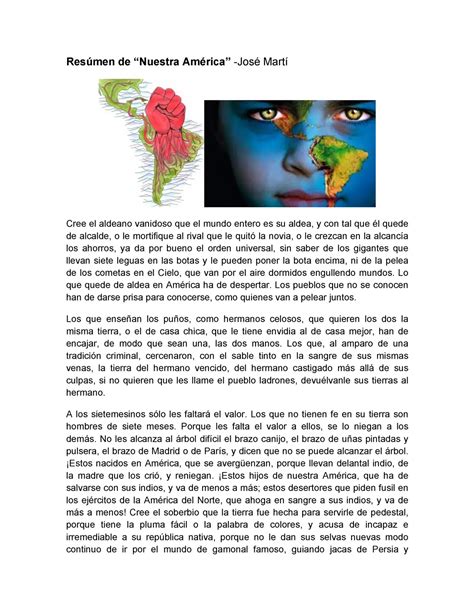Introduction
José Martí, a renowned Cuban poet, writer, and revolutionary, penned “Nuestra América” in 1891. This seminal essay articulates Martí’s profound vision for a unified, sovereign, and equitable Latin America, a concept he termed “Nuestra América.” In “Nuestra América,” Martí challenges prevailing Eurocentric ideologies, celebrates the unique cultural heritage of Latin America, and advocates for its political and economic independence.

Key Themes in “Nuestra América”
Unity and Sovereignty
Martí emphasizes the importance of unity among Latin American nations, arguing that division only weakens them against external powers. He believes that Spanish colonialism has fostered divisions within Latin America, making it vulnerable to foreign intervention. Martí calls for a unified Latin America, one that is free from foreign influence and capable of determining its own destiny.
Cultural Identity
Martí celebrates the unique cultural heritage of Latin America, which he believes is a blend of Indigenous, European, and African influences. He argues that Latin Americans should embrace their own traditions, values, and languages, rather than blindly imitating European models. Martí’s emphasis on cultural identity laid the foundation for subsequent movements for cultural autonomy and self-determination in Latin America.
Political and Economic Independence
Martí argues that Latin America must achieve political and economic independence from foreign powers to truly be free. He condemns the neocolonialism practiced by the United States, which he sees as a threat to Latin American sovereignty. Martí advocates for economic policies that promote self-sufficiency and protect the interests of the working class.
Martí’s Legacy
Martí’s ideas have profoundly influenced Latin American thinkers, activists, and revolutionaries. His call for unity, cultural pride, and political and economic self-determination has resonated throughout the region. Martí’s writings inspired movements for independence, social justice, and cultural liberation, and his legacy continues to shape the political and cultural landscape of Latin America today.
The Relevance of Martí’s Vision Today
In the 21st century, Martí’s vision for Nuestra América remains highly relevant. The region faces challenges such as economic inequality, political instability, and environmental degradation. Martí’s ideas offer a framework for addressing these challenges and working towards a more just, prosperous, and equitable Latin America.
Common Mistakes to Avoid
- Mistaking “Nuestra América” for a purely political concept: Martí’s vision encompasses cultural, social, and economic aspects.
- Assuming that unity implies conformity: Martí advocated for unity amidst diversity, respecting the uniqueness of each Latin American nation.
- Overlooking Martí’s emphasis on social justice: His vision includes the eradication of poverty, inequality, and oppression.
- Ignoring the global context: Martí recognized the importance of Latin America in the global arena and advocated for international solidarity.
A Step-by-Step Approach to Implementing Martí’s Vision
- Promote educational initiatives: Enhance the teaching of Latin American history, culture, and values to foster a sense of unity and cultural identity.
- Support regional organizations: Strengthen organizations like the Organization of American States (OAS) and the Community of Latin American and Caribbean States (CELAC) to facilitate cooperation and decision-making.
- Foster economic integration: Promote trade and investment within Latin America to reduce dependence on external markets.
- Address social inequalities: Implement policies that address poverty, inequality, and discrimination, creating a more equitable society.
Benefits of Embracing Martí’s Vision
- Enhanced regional unity: A unified Latin America can better resist external interference and promote its interests on the global stage.
- Cultural preservation and revitalization: Martí’s emphasis on cultural identity empowers Latin Americans to value and preserve their unique traditions.
- Economic prosperity: Regional integration and economic self-sufficiency can lead to sustainable growth and development.
- Social justice and equity: Martí’s vision advocates for a society free from oppression, poverty, and inequality, benefiting all citizens.
Conclusion
José Martí’s “Nuestra América” continues to inspire and guide Latin Americans in their quest for unity, sovereignty, and a just and equitable society. By embracing Martí’s vision, Latin America can overcome current challenges and work towards a future where all its people can thrive.
Tables
Table 1: Key Themes in “Nuestra América”
| Theme | Description |
|---|---|
| Unity and Sovereignty | Latin America must be united and free from foreign domination. |
| Cultural Identity | Latin Americans should embrace their unique heritage. |
| Political and Economic Independence | Latin America needs to achieve political and economic self-determination. |
Table 2: Common Mistakes to Avoid
| Mistake | Description |
|---|---|
| Mistaking “Nuestra América” for a purely political concept | Martí’s vision encompasses cultural, social, and economic aspects. |
| Assuming that unity implies conformity | Martí advocated for unity amidst diversity, respecting the uniqueness of each Latin American nation. |
| Overlooking Martí’s emphasis on social justice | His vision includes the eradication of poverty, inequality, and oppression. |
| Ignoring the global context | Martí recognized the importance of Latin America in the global arena and advocated for international solidarity. |
Table 3: A Step-by-Step Approach to Implementing Martí’s Vision
| Step | Action |
|---|---|
| Promote educational initiatives | Enhance the teaching of Latin American history, culture, and values. |
| Support regional organizations | Strengthen organizations like the OAS and CELAC. |
| Foster economic integration | Promote trade and investment within Latin America. |
| Address social inequalities | Implement policies that address poverty, inequality, and discrimination. |
Table 4: Benefits of Embracing Martí’s Vision
| Benefit | Description |
|---|---|
| Enhanced regional unity | A unified Latin America can better resist external interference. |
| Cultural preservation and revitalization | Martí’s emphasis on cultural identity empowers Latin Americans to preserve their unique traditions. |
| Economic prosperity | Regional integration and economic self-sufficiency can lead to sustainable growth. |
| Social justice and equity | Martí’s vision advocates for a society free from oppression, poverty, and inequality. |
